Hydrothermally Assisted Fabrication of TiO2-Fe3O4 Composite Materials and Their Antibacterial Activity
Abstract
1. Introduction
2. Materials and Methods
2.1. Materials
2.2. Synthesis of TiO2-Fe3O4 Composites
2.3. Characterization of Synthesized Composites
2.4. Antibacterial Activity
3. Results and Discussion
3.1. Dispersion and Morphology
3.2. Crystalline Structure
3.3. Parameters of the Porous Structure
3.4. Magnetic Properties
3.5. FTIR Spectroscopy
3.6. Thermal Analysis
3.7. Antibacterial Properties
4. Conclusions
Author Contributions
Funding
Conflicts of Interest
References
- Ma, W.; Zhang, T.; Li, R.; Niu, Y.; Yang, X.; Liu, J.; Xu, Y. Bienzymatic synergism of vanadium oxide nanodots to efficiently eradicate drug-resistant bacteria during wound healing in vivo. J. Colloid Interface Sci. 2020, 559, 313–323. [Google Scholar] [CrossRef] [PubMed]
- Han, D.; Han, Y.; Li, J.; Liu, X.; Wai, K.; Yeung, K.; Zheng, Y.; Cui, Z.; Yang, X.; Liang, Y.; et al. Enhanced photocatalytic activity and photothermal effects of Cu-doped metal-organic frameworks for rapid treatment of bacteria-infected wounds. Applied Catal. B Environ. 2020, 261, 118248. [Google Scholar] [CrossRef]
- Sun, J.; Fan, Y.; Zhang, P.; Zhang, X.; Zhou, Q.; Zhao, J.; Ren, L. Self-enriched mesoporous silica nanoparticle composite membrane with remarkable photodynamic antimicrobial performances. J. Colloid Interface Sci. 2020, 559, 197–205. [Google Scholar] [CrossRef] [PubMed]
- Szyszka, K.; Rewak-Soroczynska, J.; Dorotkiewicz-Jach, A.; Ledwa, K.A.; Piecuch, A.; Giersig, M.; Drulis-Kawa, Z.; Wiglusz, R.J. Structural modification of nanohydroxyapatite Ca10(PO4)6(OH)2 related to Eu3+ and Sr2+ ions doping and its spectroscopic and antimicrobial properties. J. Inorg. Biochem. 2020, 203, 110884. [Google Scholar] [CrossRef]
- Thukkaram, M.; Cools, P.; Nikiforov, A.; Rigole, P.; Coenye, T.; Van Der Voort, P.; Du Laing, G.; Vercruysse, C.; Declercq, H.; Morent, R.; et al. Antibacterial activity of a porous silver doped TiO2 coating on titanium substrates synthesized by plasma electrolytic oxidation. Appl. Surf. Sci. 2020, 500, 144235. [Google Scholar] [CrossRef]
- Patel, U.; Moss, R.M.; Hossain, K.M.Z.; Kennedy, A.R.; Barney, E.R.; Ahmed, I.; Hannon, A.C. Structural and physico-chemical analysis of calcium/strontium substituted, near-invert phosphate based glasses for biomedical applications. Acta Biomater. 2017, 60, 109–127. [Google Scholar] [CrossRef]
- Chen, F.; Liu, X. Advancing biomaterials of human origin for tissue engineering. Prog. Polym. Sci. 2016, 53, 86–168. [Google Scholar] [CrossRef]
- Abramova, A.V.; Abramov, V.O.; Bayazitov, V.M.; Voitov, Y.; Straumal, E.A.; Lermontov, S.A.; Cherdyntseva, T.A.; Braeutigam, P.; Weiße, M.; Günther, K. A sol-gel method for applying nanosized antibacterial particles to the surface of textile materials in an ultrasonic field. Ultrason. Sonochem. 2020, 60, 104788. [Google Scholar] [CrossRef]
- Mrówczyński, R.; Jędrzak, A.; Szutkowski, K.; Grześkowiak, B.F.; Coy, E.; Markiewicz, R.; Jesionowski, T.; Jurga, S. Cyclodextrin-based magnetic nanoparticles for cancer therapy. Nanomaterials 2018, 8, 170. [Google Scholar] [CrossRef]
- Shane, H.L.; Lukomska, E.; Anderson, S. Topical application of the quaternary ammonium compound didecyldimethylammonium chloride activates type 2 innate lymphoid cells and initiates a mixed-type allergic response. J. Allergy Clin. Immunol. 2019, 143, AB1. [Google Scholar] [CrossRef]
- Baek, S.; Joo, S.H.; Su, C.; Toborek, M. Antibacterial effects of graphene- and carbon-nanotube-based nanohybrids on Escherichia coli: Implications for treating multidrug-resistant bacteria. J. Environ. Manag. 2019, 247, 214–223. [Google Scholar] [CrossRef] [PubMed]
- Durić, S.; Vojnovic, S.; Pavic, A.; Mojicevic, M.; Wadepohl, H.; Savić, N.D.; Popsavin, M.; Nikodinovic-Runic, J.; Djuran, M.; Glišić, B.D. New polynuclear 1,5-naphthyridine-silver(I) complexes as potential antimicrobial agents: The key role of the nature of donor coordinated to the metal center. J. Inorg. Biochem. 2020, 203, 110872. [Google Scholar] [CrossRef] [PubMed]
- Sagadevan, S.; Vennila, S.; Marlinda, A.R.; Al-Douri, Y.; Johan, M.R.; Lett, J.A. Synthesis and evaluation of the structural, optical, and antibacterial properties of copper oxide nanoparticles. Appl. Phys. A 2019, 125, 489. [Google Scholar] [CrossRef]
- Vijayan, R.; Joseph, S.; Mathew, B. Anticancer, antimicrobial, antioxidant, and catalytic activities of green-synthesized silver and gold nanoparticles using Bauhinia purpurea leaf extract. Bioprocess Biosyst. Eng. 2019, 42, 305–319. [Google Scholar] [CrossRef]
- Chegeni, M.; Pour, S.K.; Dizaji, B.F. Synthesis and characterization of novel antibacterial sol-gel derived TiO2/Zn2TiO4/Ag nanocomposite as an active agent. Ceram. Int. 2019, 45, 23857–24954. [Google Scholar] [CrossRef]
- Matsunaga, T.; Tomoda, R.; Nakajima, T.; Wake, H. Photoelectrochemical sterilization of microbial cells by semiconductor powders. FEMS Microbiol. Lett. 1985, 29, 211–214. [Google Scholar] [CrossRef]
- Kikuchi, Y.; Sunada, K.; Iyoda, T.; Hashimoto, K.; Fujishima, A. Photocatalytic bactericidal effect of TiO2 thin films: Dynamic view of the active oxygen species responsible for the effect. J. Photochem. Photobiol. A 1997, 106, 51–56. [Google Scholar] [CrossRef]
- Nadtochenko, V.; Denisov, N.; Sarkisov, O.; Gumy, D.; Pulgarin, C.; Kiwi, J. Laser kinetic spectroscopy of the interfacial charge transfer between membrane cell walls of E. coli and TiO2. J. Photochem. Photobiol. A 2006, 181, 401–407. [Google Scholar] [CrossRef]
- Liu, Y.; Wang, X.; Yang, F.; Yang, X. Excellent antimicrobial properties of mesoporous anatase TiO2 and Ag/TiO2 composite films. Microporous Mesoporous Mater. 2008, 114, 431–439. [Google Scholar] [CrossRef]
- Lendzion-Bieluń, Z.; Wojciechowska, A.; Grzechulska-Damszel, J.; Narkiewicz, U.; Śniadecki, Z.; Idzikowski, B. Effective processes of phenol degradation on Fe3O4–TiO2 nanostructured magnetic photocatalyst. J. Phys. Chem. Solids 2020, 136, 109178. [Google Scholar] [CrossRef]
- Sun, J.; Zhou, S.; Hou, P.; Yang, Y.; Weng, J.; Li, X.; Li, M. Synthesis and characterization of biocompatible Fe3O4 nanoparticles. J. Biomed. Mater. Res. A. 2006, 80, 333–341. [Google Scholar] [CrossRef] [PubMed]
- Wang, W.; Zhu, Y.; Ruan, M. Microwave-assisted synthesis and magnetic property of magnetite and hematite nanoparticles. J. Nanoparticle Res. 2007, 9, 419–426. [Google Scholar] [CrossRef]
- Chin, S.F.; Makha, M.; Raston, L.C.; Saunders, M. Magnetite ferrofluids stabilized by sulfonato-calixarenes. Chem. Commun. 2007, 1948–1950. [Google Scholar] [CrossRef] [PubMed]
- Lee, H.; Shao, H.; Huang, Y.; Kwak, B. Synthesis of MRI contrast agent by coating superparamagnetic iron oxide with chitosan. IEEE Trans. Magn. 2005, 41, 4102–4104. [Google Scholar] [CrossRef]
- Jurgons, R.; Seliger, C.; Hilpert, A.; Trahms, L.; Odenbach, S.; Alexiou, C. Drug loaded magnetic nanoparticles for cancer therapy. J. Phys. Condens. Matter 2006, 18, 2893. [Google Scholar] [CrossRef]
- Wang, X.; Liao, Y.; Zhang, D.; Wen, T.; Zhong, Z. A review of Fe3O4 thin films: Synthesis, modification and applications. J. Mater. Sci. Technol. 2018, 34, 1259–1272. [Google Scholar] [CrossRef]
- Xu, Z.P.; Zeng, Q.H.; Lu, G.Q.; Yu, A.B. Inorganic nanoparticles as carriers for efficient cellular delivery. Chem. Eng. Sci. 2006, 61, 1027–1040. [Google Scholar] [CrossRef]
- Ghazanfari, M.R.; Kashefi, M.; Shams, S.F.; Jaafari, M.R. Perspective of Fe3O4 nanoparticles role in biomedical applications. Biochem. Res. Int. 2016, 2016, 7840161. [Google Scholar] [CrossRef]
- Wang, J.; Zheng, S.; Shao, Y.; Liu, J.; Xu, Z.; Zhu, D. Amino-functionalized Fe3O4@SiO2 core–shell magnetic nanomaterial as a novel adsorbent for aqueous heavy metals removal. J. Colloid Interface Sci. 2010, 349, 293–299. [Google Scholar] [CrossRef]
- Fan, F.L.; Qin, Z.; Bai, J.; Rong, W.D.; Fan, F.Y.; Tian, W.; Wu, X.L.; Wang, Y.; Zhao, L. Rapid removal of uranium from aqueous solutions using magnetic Fe3O4@SiO2 composite particles. J. Environ. Radioact. 2012, 106, 40–46. [Google Scholar] [CrossRef] [PubMed]
- Zhu, Y.; Ikoma, T.; Hanagata, N.; Kaskel, S. Rattle-type Fe3O4@SiO2 hollow mesoporous spheres as carriers for drug delivery. Small 2010, 6, 471–478. [Google Scholar] [CrossRef] [PubMed]
- Shao, M.; Ning, F.; Zhao, J.; Wei, M.; Evans, D.G.; Duan, X. Preparation of Fe3O4@SiO2@layered double hydroxide core–shell microspheres for magnetic separation of proteins. J. Am. Chem. Soc. 2012, 134, 1071–1077. [Google Scholar] [CrossRef] [PubMed]
- Wu, K.; Jing, C.; Zhang, J.; Liu, T.; Yang, S.; Wang, W. Magnetic Fe3O4@CuO nanocomposite assembled on graphene oxide sheets for the enhanced removal of arsenic (III/V) from water. Appl. Surf. Sci. 2018, 466, 746–756. [Google Scholar] [CrossRef]
- Zhang, Y.; Qiu, L.; Yuan, Y.; Zhu, Y.; Jiang, X.; Xiao, J. Magnetic Fe3O4@C/Cu and Fe3O4@CuO core—Shell composites constructed from MOF-based materials and their photocatalytic properties under visible light. Applied Catal. B Environ. 2014, 144, 863–869. [Google Scholar] [CrossRef]
- Vinosel, V.M.; Anand, S.; Janifer, M.A.; Pauline, S. Photocatalytic and antibacterial applications of magnetic Fe3O4-CuO nanocomposite. Mater. Today Proc. 2019, 8, 301–309. [Google Scholar] [CrossRef]
- Rajabi, S.K.; Sohrabnezhad, S.; Ghafourian, S. Fabrication of Fe3O4@CuO core-shell from MOF based materials and its antibacterial activity. J. Solid State Chem. 2016, 244, 160–163. [Google Scholar] [CrossRef]
- Raza, A.; Shen, H.; Haidry, A.A.; Cui, S. Hydrothermal synthesis of Fe3O4/TiO2/g-C3N4: Advanced photocatalytic application. Appl. Surf. Sci. 2019, 488, 887–895. [Google Scholar] [CrossRef]
- Mehdipour, M.; Pirbazari, A.E.; Khayati, G. Cobalt photodeposition on Fe3O4/TiO2 as a novel magnetically separable visible-light-driven photocatalyst for efficient degradation of 2,4-dichlorophenol. Desalination Water Treat. 2019, 155, 329–340. [Google Scholar] [CrossRef]
- Zabihisahebi, A.; Koushkbaghi, S.; Pishnamazi, M.; Askari, A.; Khosravi, R.; Irani, M. Synthesis of cellulose acetate/chitosan/SWCNT/Fe3O4/TiO2 composite nano fibers for the removal of Cr(VI), As(V), Methylene blue and Congo red from aqueous solutions. Int. J. Biol. Macromol. 2019, 140, 1296–1304. [Google Scholar] [CrossRef]
- Beduk, F. Superparamagnetic nanomaterial Fe3O4–TiO2 for the removal of As(V) and As(III) from aqueous solutions. Environ. Technol. 2016, 37, 1790–1801. [Google Scholar] [CrossRef]
- Zeng, L.; Ren, W.; Xiang, L.; Zheng, J.; Chen, B.; Wu, A. Multifunctional Fe3O4–TiO2 nanocomposites for magnetic resonance imaging and potential photodynamic therapy. Nanoscale 2013, 5, 2107–2113. [Google Scholar] [CrossRef]
- Arabzadeh, N.; Mohammadi, A.; Darwish, M.; Abuzerr, S. Construction of a TiO2–Fe3O4—Decorated molecularly imprinted polymer nanocomposite for tartrazine degradation: Response surface methodology modeling and optimization. J. Chinese Chem. Soc. 2019, 66, 474–483. [Google Scholar] [CrossRef]
- Babudurai, M.; Hernandez-Maya, R.; Solís, M.; Th-Th, C.; Velumani, S. Photocatalytic degradation of Orange G using TiO2/Fe3O4 nanocomposites. J. Mater. Sci. Mater. Electron. 2018, 29, 15436–15444. [Google Scholar] [CrossRef]
- Salamat, S.; Younesi, H.; Bahramifar, N. Synthesis of magnetic core-shell Fe3O4@TiO2 nanoparticles from electric arc furnace dust for photocatalytic degradation of steel mill wastewater. RSC Adv. 2017, 7, 19391–19405. [Google Scholar] [CrossRef]
- Kermani, M.; Kakavandi, B.; Farzadkia, M.; Esrafili, A.; Jokandan, S.F.; Shahsavani, A. Catalytic ozonation of high concentrations of catechol over TiO2@Fe3O4 magnetic core-shell nanocatalyst: Optimization, toxicity and degradation pathway studies. J. Clean. Prod. 2018, 192, 597–607. [Google Scholar] [CrossRef]
- Li, Y.; Zhang, M.; Guo, M.; Wang, X. Preparation and properties of a nano TiO2/Fe3O4 composite superparamagnetic photocatalyst. Rare Met. 2009, 28, 423–427. [Google Scholar] [CrossRef]
- Li, Z.Q.; Wang, H.L.; Zi, L.Y.; Zhang, J.J.; Zhang, Y.S. Preparation and photocatalytic performance of magnetic TiO2-Fe3O4/graphene (RGO) composites under VIS-light irradiation. Ceram. Int. 2015, 41, 10634–10643. [Google Scholar] [CrossRef]
- Bui, V.K.H.; Park, D.; Pham, T.N.; An, Y.; Choi, J.S.; Lee, H.U.; Kwon, O.H.; Moon, J.Y.; Kim, K.T.; Lee, Y.C. Synthesis of MgAC-Fe3O4/TiO2 hybrid nanocomposites via sol-gel chemistry for water treatment by photo-Fenton and photocatalytic reactions. Sci. Rep. 2019, 9, 1–11. [Google Scholar] [CrossRef]
- Beketova, D.; Motola, M.; Sopha, H.; Michalicka, J.; Cicmancova, V.; Dvorak, F.; Hromadko, L.; Frumarova, B.; Stoica, M.; Macak, J.M. One-step decoration of TiO2 nanotubes with Fe3O4 nanoparticles: Synthesis and photocatalytic and magnetic properties. ACS Appl. Nano Mater. 2020, 3, 1553–1563. [Google Scholar] [CrossRef]
- Rodríguez-Carvajal, J. Recent advances in magnetic structure determination by neutron powder diffraction. Phys. B 1993, 192, 55–69. [Google Scholar] [CrossRef]
- CLSI. Performance Standards for Antimicrobial Susceptibility Testing, 29th ed.; CLSI supplement M100; Clinical and Laboratory Standards Institute: Wayne, PA, USA, 2019. [Google Scholar]
- ASTM. E2149—01 Standard Methods for Determining the Antimicrobial Activity of Immobilized Antimicrobial Agents under Dynamic Contact Conditions; ASTM International: West Conshohocken, PA, USA, 2008. [Google Scholar]
- Karatutlu, A.; Barhoum, A.; Sapelkin, A. Theories of nanoparticle and nanostructure formation in liquid phase. In Emerging Applications of Nanoparticles and Architecture Nanostructures; Barhoum, A., Makhlouf, A.S.H., Eds.; Elsevier Inc.: Amsterdam, The Netherlands, 2018; pp. 597–619. [Google Scholar] [CrossRef]
- Wang, P.; Yi, Q.; Xing, M.; Zhang, J. Selective synthesis of TiO2 single nanocrystals and titanate nanotubes: A controllable atomic arrangement approach via NH4TiOF3 mesocrystals. Phys. Chem. Chem. Phys. 2015, 17, 21982–21987. [Google Scholar] [CrossRef] [PubMed]
- Martínez-Mera, I.; Espinosa-Pesqueira, M.E.; Pérez-Hernández, R.; Arenas-Alatorre, J. Synthesis of magnetite (Fe3O4) nanoparticles without surfactants at room temperature. Mater. Lett. 2007, 61, 4447–4451. [Google Scholar] [CrossRef]
- Jędrzak, A.; Rębiś, T.; Kuznowicz, M.; Jesionowski, T. Bio-inspired magnetite/lignin/polydopamine-glucose oxidase biosensing nanoplatform. From synthesis, via sensing assays to comparison with others glucose testing techniques. Int. J. Biol. Macromol. 2019, 127, 677–682. [Google Scholar] [CrossRef]
- Siwińska-Stefańska, K.; Zdarta, J.; Paukszta, D.; Jesionowski, T. The influence of addition of a catalyst and chelating agent on the properties of titanium dioxide synthesized via the sol–gel method. J. Sol. Gel Sci. Technol. 2015, 75, 264–278. [Google Scholar] [CrossRef]
- Siwińska-Stefańska, K.; Ciesielczyk, F.; Kołodziejczak-Radzimska, A.; Paukszta, D.; Sójka-Ledakowicz, J.; Jesionowski, T. TiO2-SiO2 inorganic barrier composites: From synthesis to application. Pigment Resin Technol. 2012, 41, 139–148. [Google Scholar] [CrossRef]
- Tan, L.; Zhang, X.; Liu, Q.; Jing, X.; Liu, J.; Song, D.; Hu, S.; Liu, L.; Wang, J. Synthesis of Fe3O4TiO2 core-shell magnetic composites for highly efficient sorption of uranium (VI). Colloids Surf. A Physicochem. Eng. Asp. 2015, 469, 279–286. [Google Scholar] [CrossRef]
- Khashan, S.; Dagher, S.; Tit, N.; Alazzam, A.; Obaidat, I. Novel method for synthesis of Fe3O4@TiO2 core/shell nanoparticles. Surf. Coat. Technol. 2017, 322, 92–98. [Google Scholar] [CrossRef]
- Zhu, L.; Zhang, M.; Qiao, Y.; Xiao, G.; Zhang, F.; Chen, Y. Fe3O4/TiO2 core/shell nanotubes: Synthesis and magnetic and electromagnetic wave absorption characteristics. J. Phys. Chem. C 2010, 114, 16229–16235. [Google Scholar] [CrossRef]
- Chen, C.T.; Chen, Y.C. Fe3O4/TiO2 core/shell nanoparticles as affinity probes for the analysis of phosphopeptides using TiO2 surface-assisted laser desorption/ionization mass spectrometry. Anal. Chem. 2005, 77, 5912–5919. [Google Scholar] [CrossRef] [PubMed]
- Feizpoor, S.; Habibi-yangjeh, A. Ternary TiO2/Fe3O4/CoWO4 nanocomposites: Novel magnetic visible-light-driven photocatalysts with substantially enhanced activity through p-n heterojunction. J. Colloid Interface Sci. 2018, 524, 325–336. [Google Scholar] [CrossRef]
- Shojei, A.F.; Shams-Nateri, A.; Ghomashpasand, M. Comparative study of photocatalytic activities of magnetically separable WO3/TiO2/Fe3O4 nanocomposites and TiO2, WO3/TiO2 and TiO2/Fe3O4 under visible light irradiation. Superlattices Microstruct. 2015, 88, 211–224. [Google Scholar] [CrossRef]
- Li, X.; Cui, M.; Lee, Y.; Choi, J.; Khim, J. Application of pea-like yolk–shell structured Fe3O4@TiO2 nanosheets for photocatalytic and photo-fenton oxidation of bisphenol-A. RSC Adv. 2019, 9, 22153–22160. [Google Scholar] [CrossRef]
- Shojaie, A.; Fattahi, M.; Jorfi, S.; Ghasemi, B. Synthesis and evaluations of Fe3O4–TiO2–Ag nanocomposites for photocatalytic degradation of 4-chlorophenol (4-CP): Effect of Ag and Fe compositions. Int. J. Ind. Chem. 2018, 9, 141–151. [Google Scholar] [CrossRef]
- Fisli, A.; Saridewi, R.; Dewi, S.H.; Gunlazuardi, J. Preparation and characterization of Fe3O4/TiO2 composites by heteroagglomeration. Adv. Mater. Res. 2013, 626, 131–137. [Google Scholar] [CrossRef]
- Bruvera, I.J.; Mendoza Zélis, P.; Pilar Calatayud, M.; Goya, G.F.; Sánchez, F.H. Determination of the blocking temperature of magnetic nanoparticles: The good, the bad, and the ugly. J. Appl. Phys. 2015, 118, 184304. [Google Scholar] [CrossRef]
- Walz, F. The Verwey transition—A topical review. J. Phys. Condens. Matter 2002, 14, 285–340. [Google Scholar] [CrossRef]
- Yang, J.B.; Zhou, X.D.; Yelon, W.B.; James, W.J.; Cai, Q.; Gopalakrishnan, K.V.; Malik, S.K.; Sun, X.C.; Nikles, D.E. Magnetic and structural studies of the Verwey transition in Fe3-δO4 nanoparticles. J. Appl. Phys. 2004, 95, 7540–7542. [Google Scholar] [CrossRef]
- Mitra, A.; Mohapatra, J.; Meena, S.S.; Tomy, C.V.; Aslam, M. Verwey transition in ultrasmall-sized octahedral Fe3O4 nanoparticles. J. Phys. Chem. C 2014, 118, 19356–19362. [Google Scholar] [CrossRef]
- Lee, J.; Kwon, S.G.; Park, J.G.; Hyeon, T. Size dependence of metal-insulator transition in stoichiometric Fe3O4 nanocrystals. Nano Lett. 2015, 15, 4337–4342. [Google Scholar] [CrossRef]
- Nedelkoski, Z.; Kepaptsoglou, D.; Lari, L.; Wen, T.; Booth, R.A.; Oberdick, S.D.; Galindo, P.L.; Ramasse, Q.M.; Evans, R.F.L.; Majetich, S.; et al. Origin of reduced magnetization and domain formation in small magnetite nanoparticles. Sci. Rep. 2017, 7, 1–8. [Google Scholar] [CrossRef]
- Chauvet, O.; Forro, L.; Kos, I.; Miljak, M. Magnetic properties of the anatase phase of TiO2. Solid State Commun. 1995, 93, 667–669. [Google Scholar] [CrossRef]
- Majetich, S.A.; Wen, T.; Mefford, O.T. Magnetic nanoparticles. MRS Bull. 2013, 38, 899–903. [Google Scholar] [CrossRef]
- Mohapatra, J.; Xing, M.; Liu, J.P. Inductive thermal effect of ferrite magnetic nanoparticles. Materials 2019, 12, 3208. [Google Scholar] [CrossRef] [PubMed]
- Kumar, P.M.; Badrinarayanan, S.; Sastry, M. Nanocrystalline TiO2 studied by optical, FTIR and X-ray photoelectron spectroscopy: Correlation to presence of surface states. Thin Solid Films 2000, 358, 122–130. [Google Scholar] [CrossRef]
- Wu, L.; Yu, J.C.; Zhang, L.; Wang, X.; Ho, W. Preparation of a highly active nanocrystalline TiO2 photocatalyst from titanium oxo cluster precursor. J. Solid State Chem. 2004, 177, 2584–2590. [Google Scholar] [CrossRef]
- Cheng, F.Y.; Su, C.H.; Yang, Y.S.; Yeh, C.S.; Tsai, C.Y.; Wu, C.L.; Wu, M.T.; Shieh, D.B. Characterization of aqueous dispersions of Fe3O4 nanoparticles and their biomedical applications. Biomaterials 2005, 26, 729–738. [Google Scholar] [CrossRef]
- Chan, C.C.; Chang, C.C.; Hsu, C.W.; Wang, S.K.; Lin, J. Photocatalytic activities of Pd-loaded mesoporous TiO2 thin films. Chem. Eng. J. 2009, 152, 492–497. [Google Scholar] [CrossRef]
- Jędrzak, A.; Rębiś, T.; Nowicki, M.; Synoradzki, K.; Mrówczyński, R.; Jesionowski, T. Polydopamine grafted on an advanced Fe3O4/lignin hybrid material and its evaluation in biosensing. Appl. Surf. Sci. 2018, 455, 455–464. [Google Scholar] [CrossRef]
- Raghunath, A.; Perumal, E. Metal oxide nanoparticles as antimicrobial agents: A promise for the future. Int. J. Antimicrob. Agents 2017, 49, 137–152. [Google Scholar] [CrossRef]
- Sievers, N.V.; Pollo, L.D.; Corção, G.; Medeiros Cardozo, N.S. In situ synthesis of nanosized TiO2 in polypropylene solution for the production of films with antibacterial activity. Mater. Chem. Phys. 2020, 246, 122824. [Google Scholar] [CrossRef]
- Yildiz, A.; Vatansever Bayramol, D.; Atav, R.; Ağirgan, A.Ö.; Aydin Kurç, M.; Ergünay, U.; Mayer, C.; Hadimani, R.L. Synthesis and characterization of Fe3O4@Cs@Ag nanocomposite and its use in the production of magnetic and antibacterial nanofibrous membranes. Appl. Surf. Sci. 2020, 521, 146332. [Google Scholar] [CrossRef]
- Tseng, W.J.; Chuang, Y.C.; Chen, Y.A. Mesoporous Fe3O4@Ag@TiO2 nanocomposite particles for magnetically recyclable photocatalysis and bactericide. Adv. Powder Technol. 2018, 29, 664–671. [Google Scholar] [CrossRef]
- Cheng, T.C.; Yao, K.S.; Yeh, N.; Chang, C.I.; Hsu, H.C.; Chien, Y.T.; Chang, C.Y. Visible light activated bactericidal effect of TiO2/Fe3O4 magnetic particles on fish pathogens. Surf. Coat. Technol. 2009, 204, 1141–1144. [Google Scholar] [CrossRef]
- Ma, S.; Zhan, S.; Jia, Y.; Zhou, Q. Superior Antibacterial Activity of Fe3O4-TiO2 nanosheets under solar light. ACS Appl. Mater. Interfaces 2015, 7, 21875–21883. [Google Scholar] [CrossRef]
- Xu, J.W.; Gao, Z.D.; Han, K.; Liu, Y.; Song, Y.Y. Synthesis of magnetically separable Ag3PO4/TiO2/Fe3O4 heterostructure with enhanced photocatalytic performance under visible light for photoinactivation of bacteria. ACS Appl. Mater. Interfaces 2014, 6, 15122–15131. [Google Scholar] [CrossRef]
- Li, C.; Younesi, R.; Cai, Y.; Zhu, Y.; Ma, M.; Zhu, J. Photocatalytic and antibacterial properties of Au-decorated Fe3O4@TiO2 core-shell microspheres. Appl. Catal. B Environ. 2014, 156, 314–322. [Google Scholar] [CrossRef]
- Foster, H.A.; Ditta, I.B.; Varghese, S.; Steele, A. Photocatalytic disinfection using titanium dioxide: Spectrum and mechanism of antimicrobial activity. Appl. Microbiol. Biotechnol. 2011, 90, 1847–1868. [Google Scholar] [CrossRef]
- Van Houdt, R.; Michiels, C.W. Role of bacterial cell surface structures in Escherichia coli biofilm formation. Res. Microbiol. 2005, 156, 626–633. [Google Scholar] [CrossRef]
- Li, W.R.; Xie, X.B.; Shi, Q.S.; Duan, S.S.; Ouyang, Y.S.; Chen, Y.B. Antibacterial effect of silver nanoparticles on Staphylococcus aureus. Biometals 2011, 135–141. [Google Scholar] [CrossRef]
- Kuhn, S.; Slavetinsky, C.J.; Peschel, A. Synthesis and function of phospholipids in Staphylococcus aureus. Int. J. Med. Microbiol. 2015, 305, 196–202. [Google Scholar] [CrossRef]
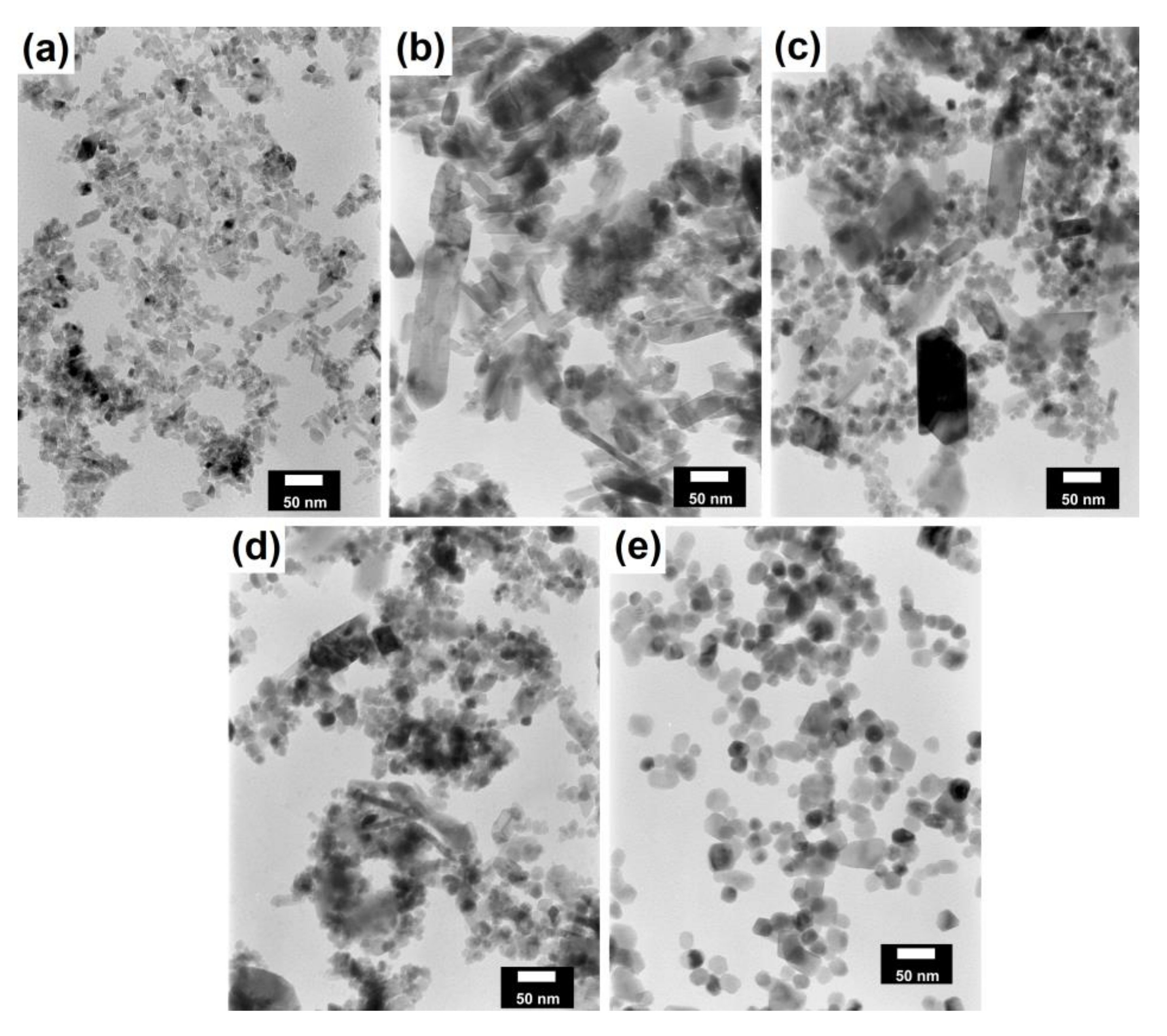
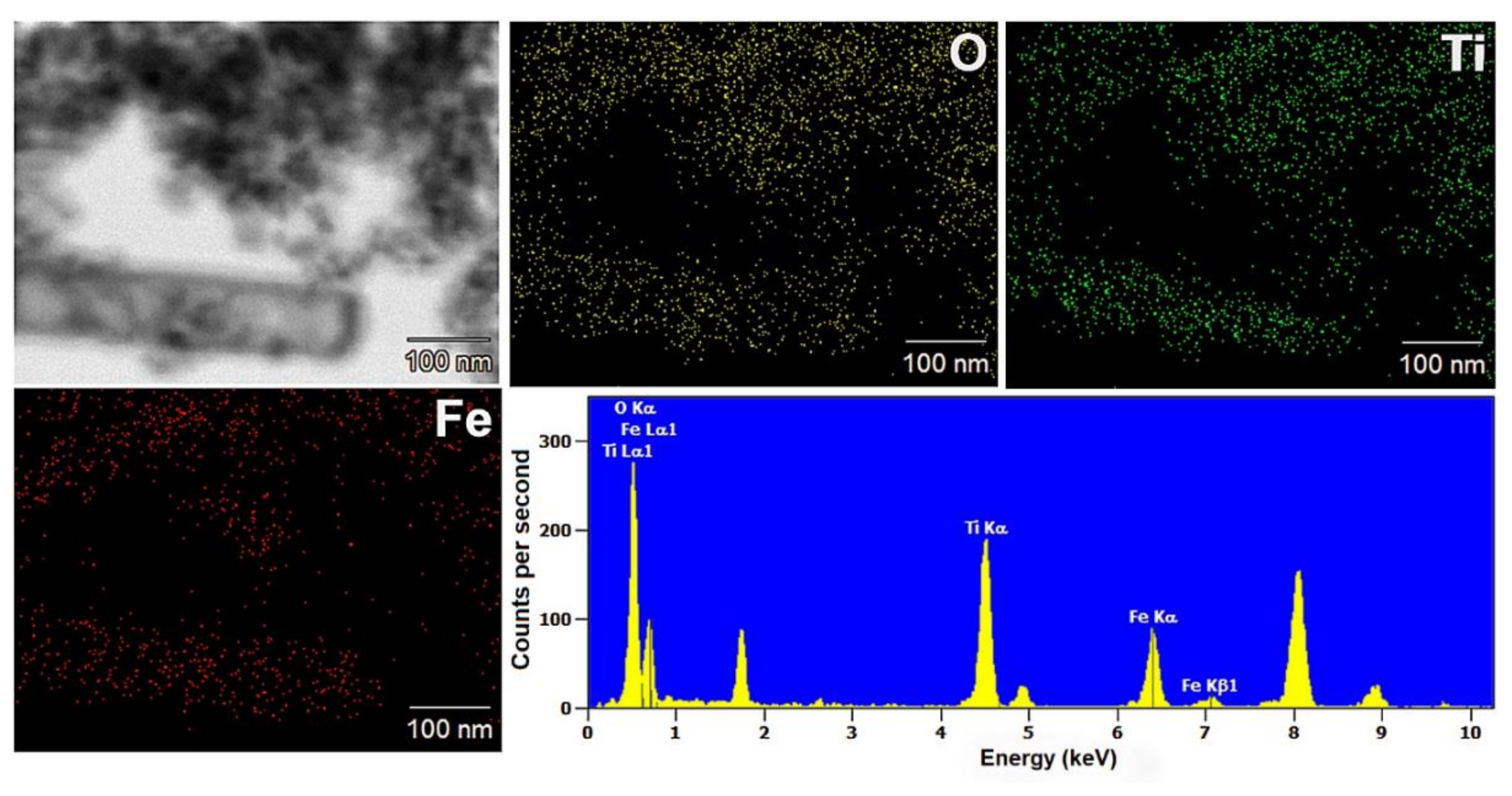
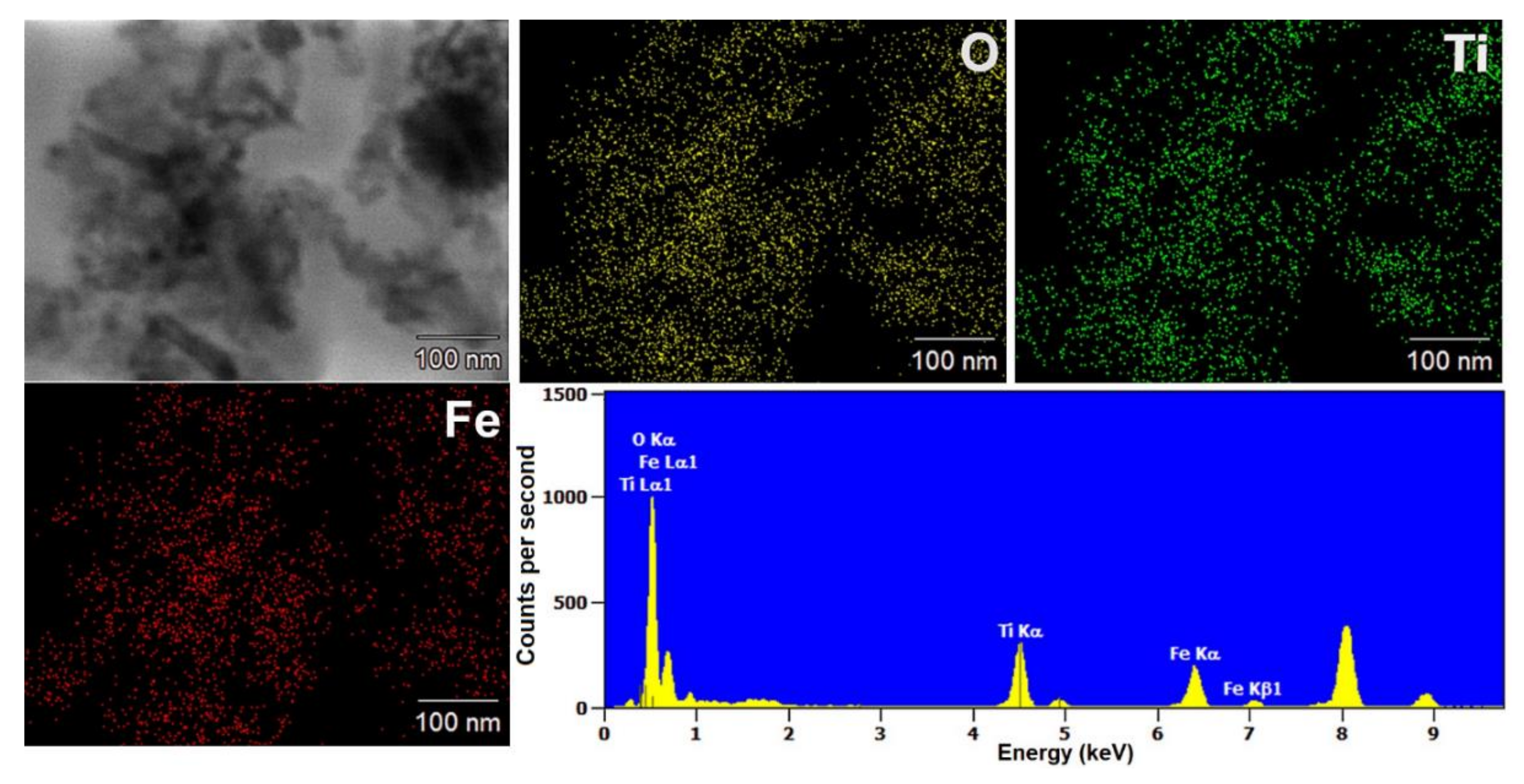

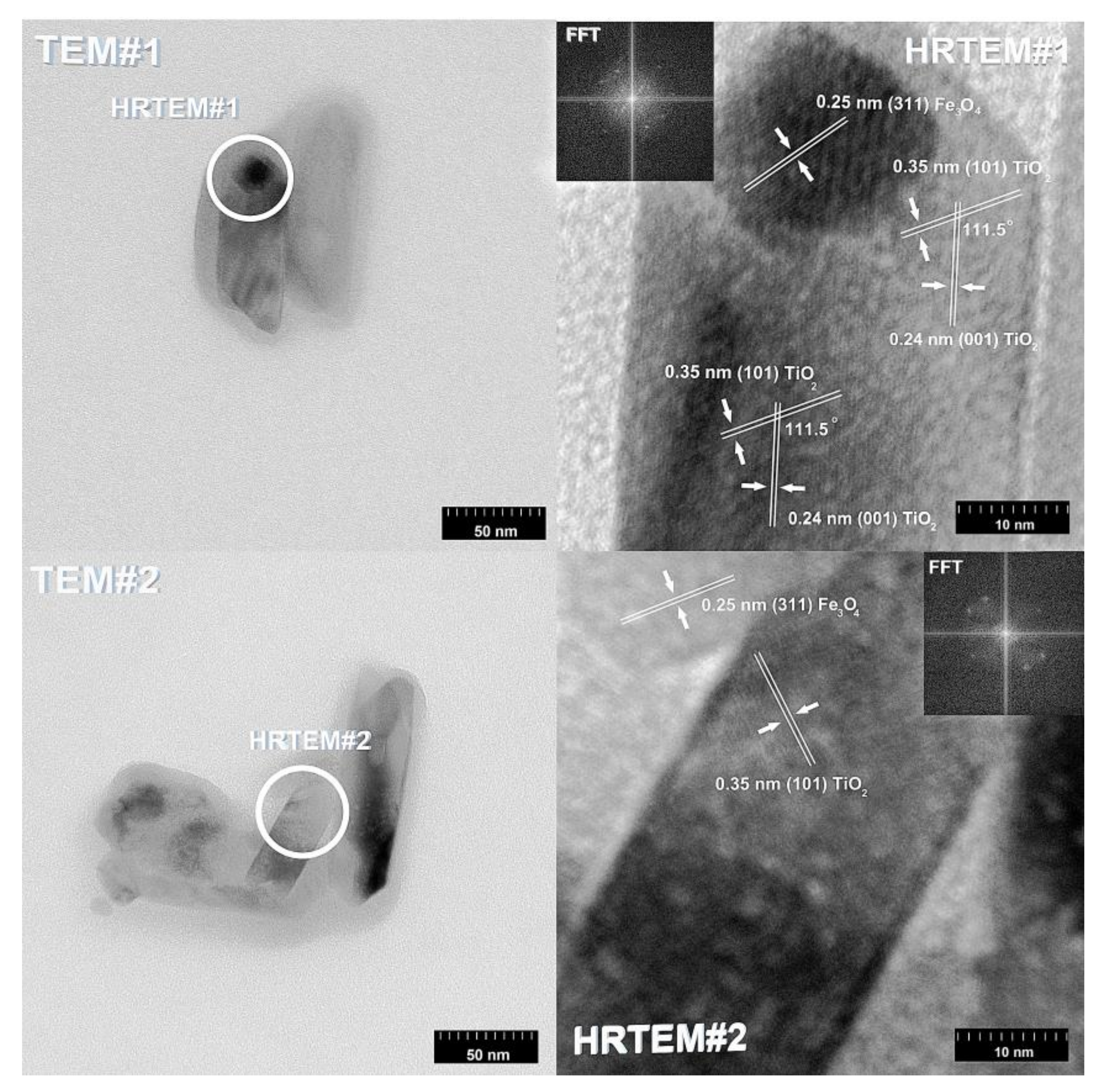
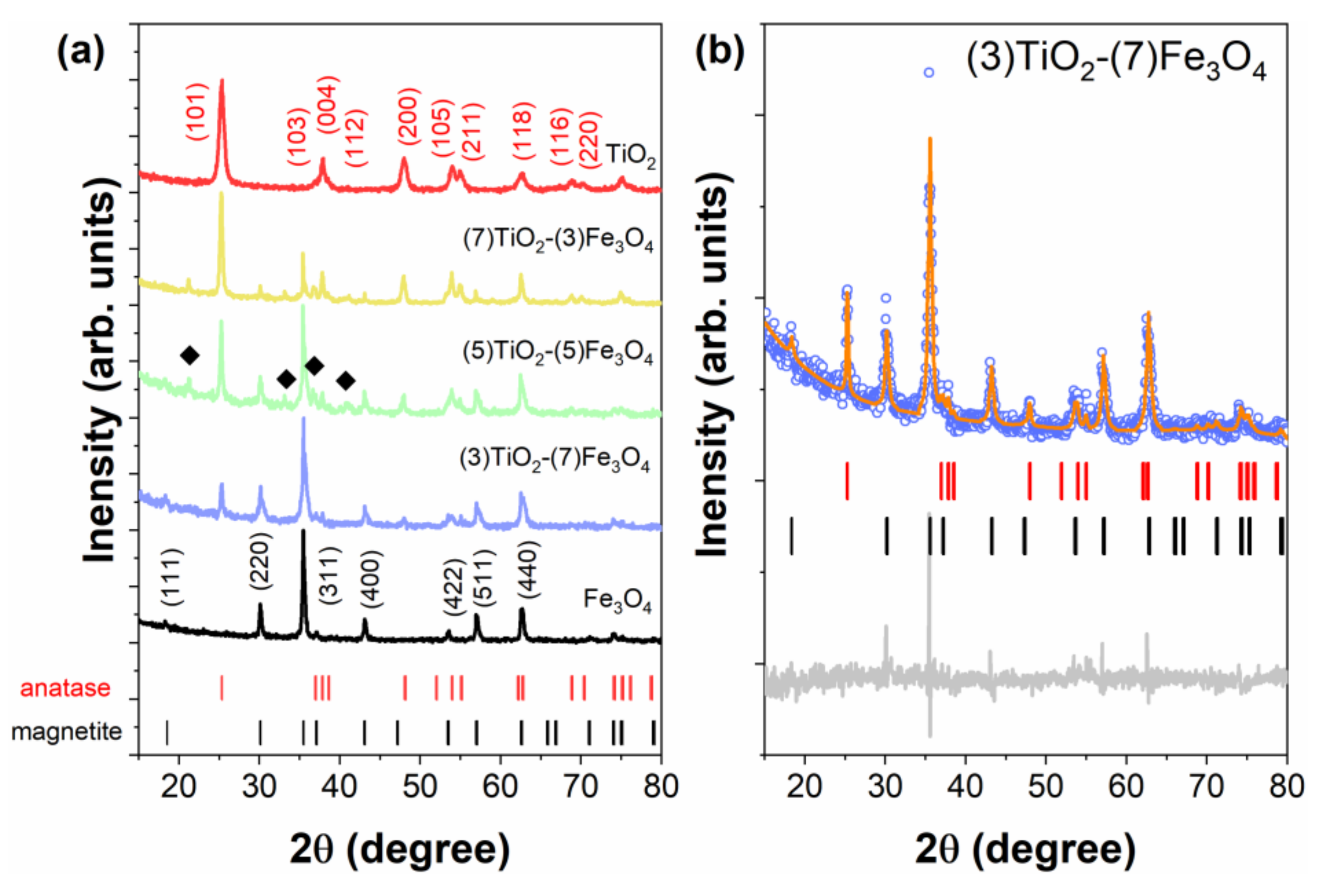
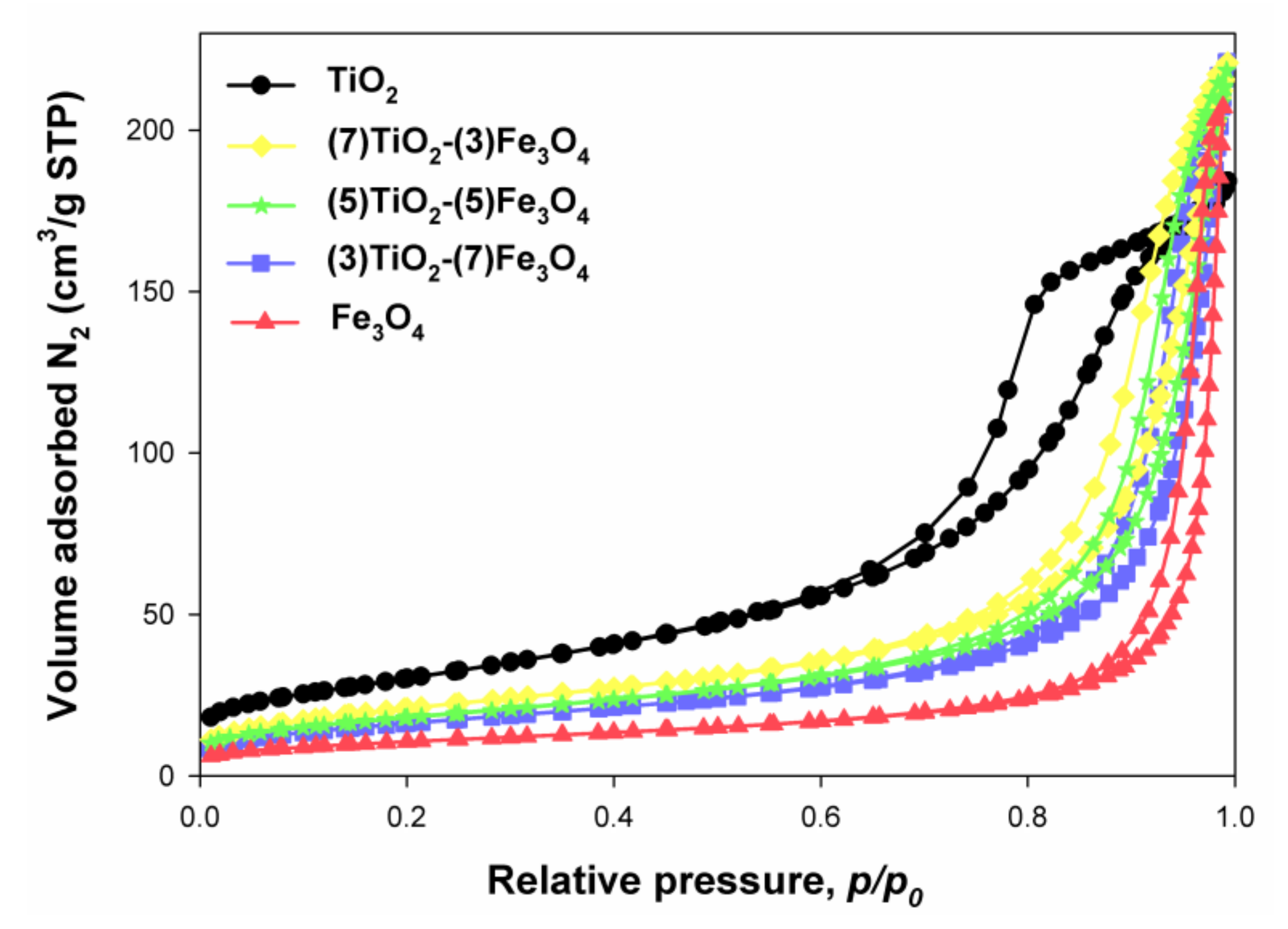
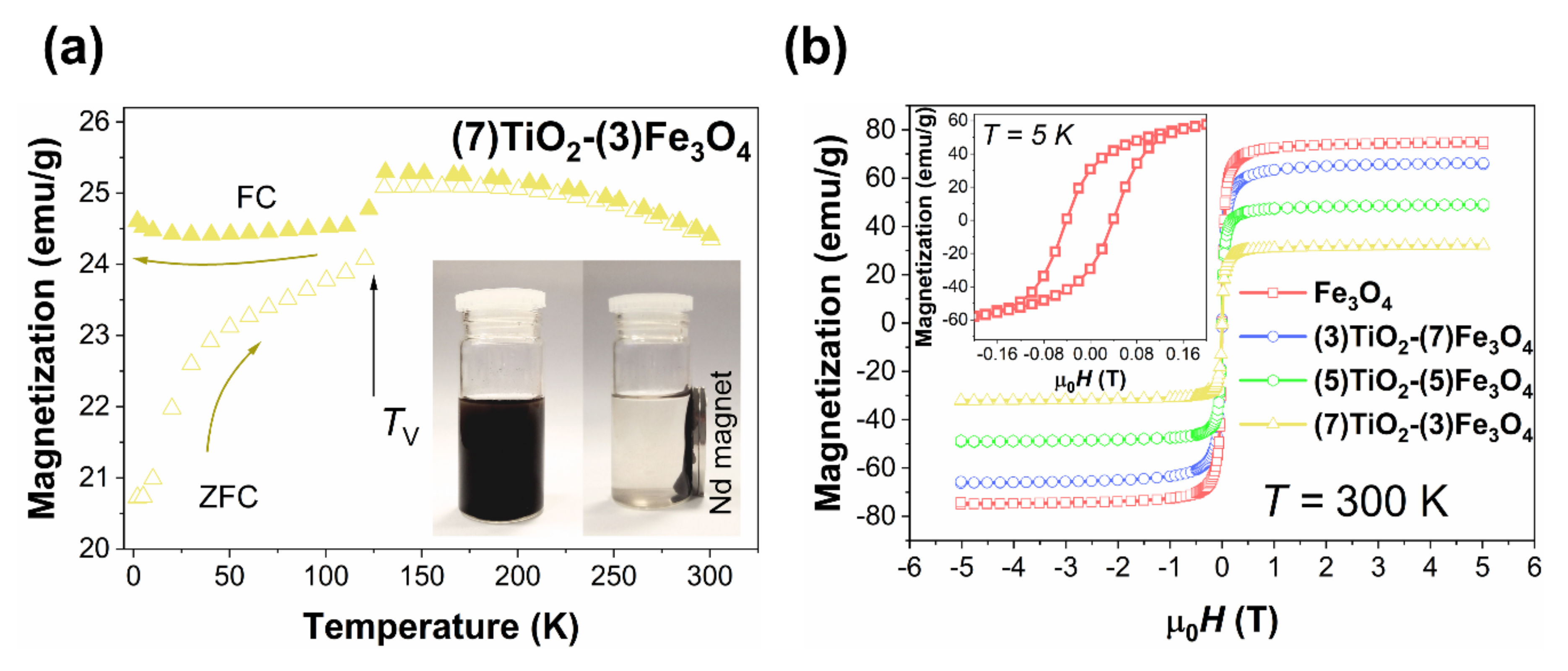
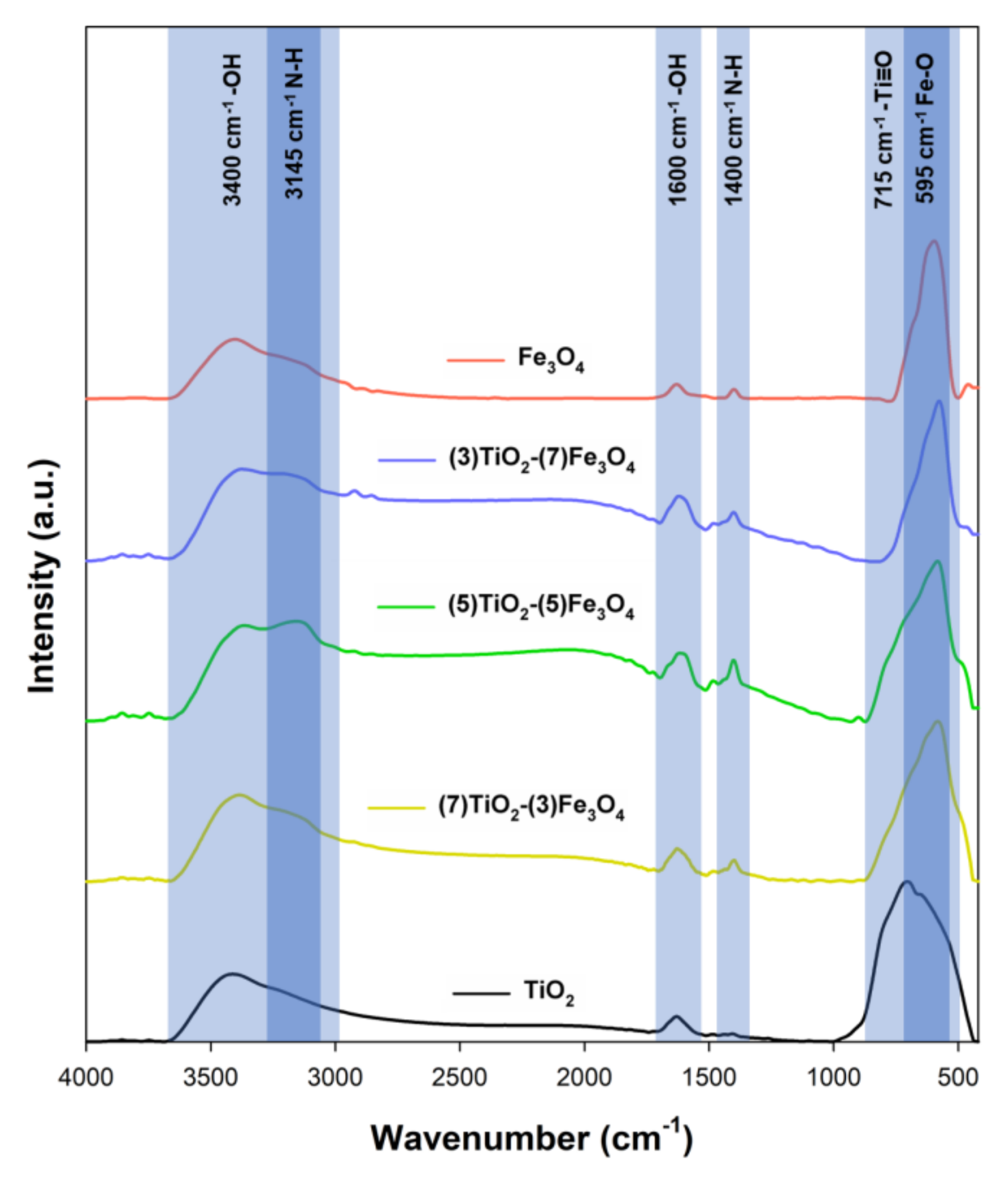
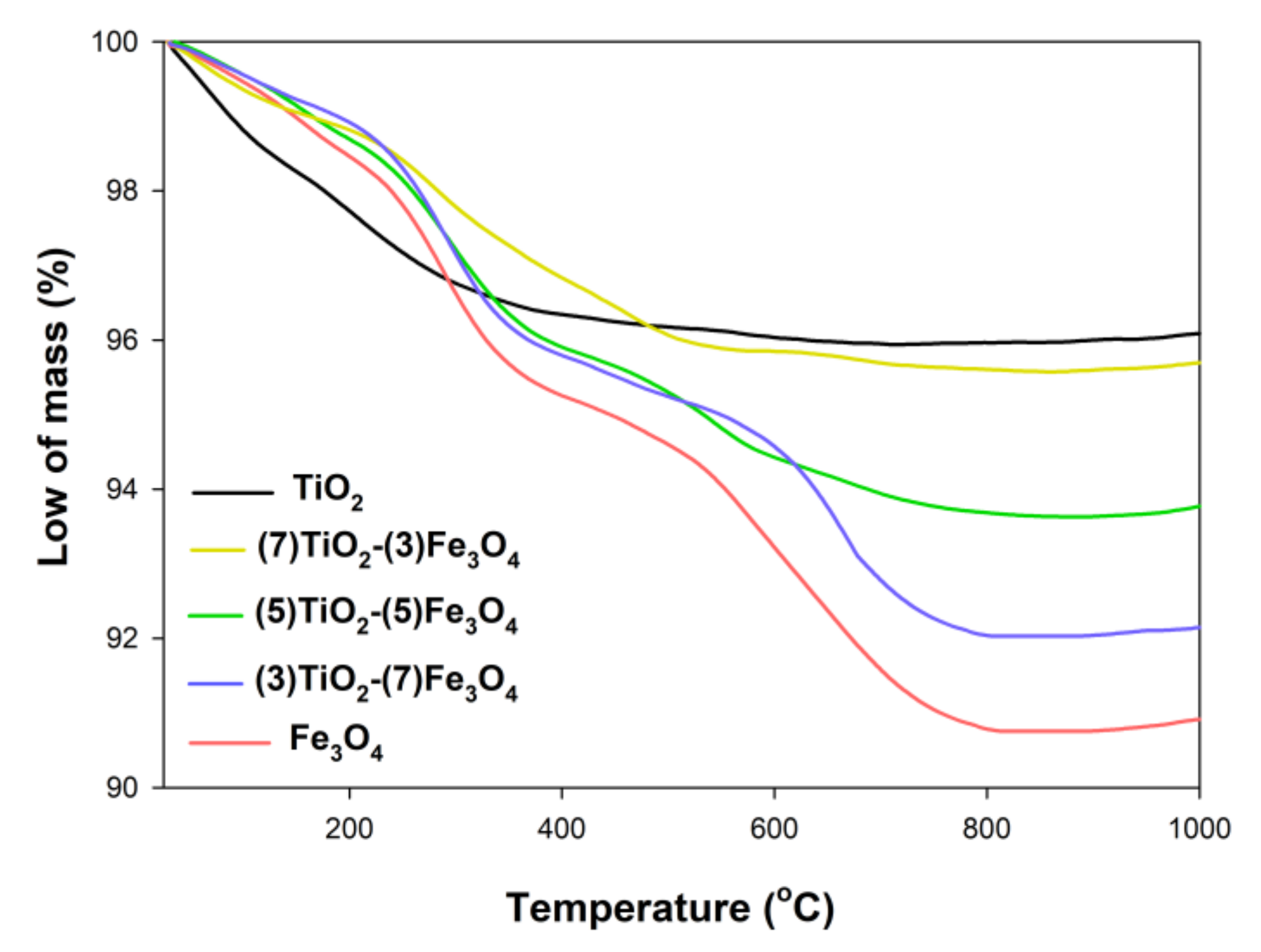
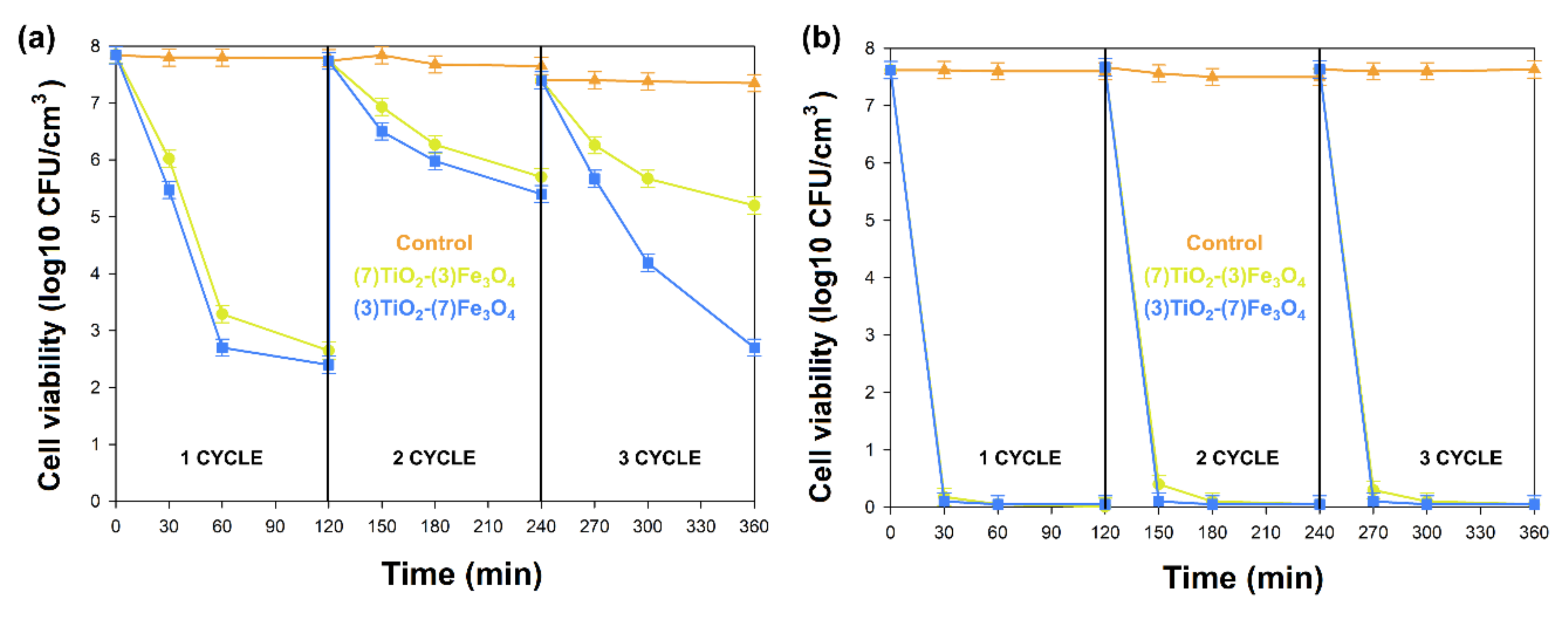
| Sample | Particle Size Distributions (PSD) | SEM Images |
|---|---|---|
| TiO2 |  | 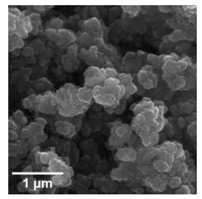 |
| (7)TiO2-(3)Fe3O4 |  | 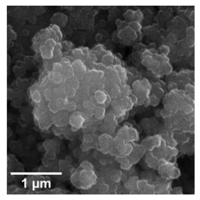 |
| (5)TiO2-(5)Fe3O4 | 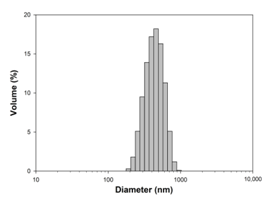 |  |
| (3)TiO2-(7)Fe3O4 | 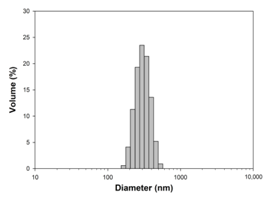 | 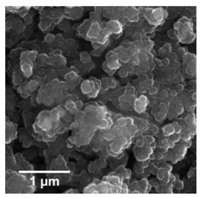 |
| Fe3O4 | 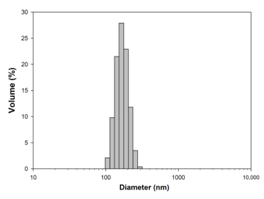 | 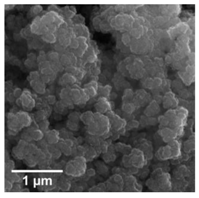 |
| Sample | Lattice Parameters | Phase Composition (wt.%) | D (nm) | ||||
|---|---|---|---|---|---|---|---|
| Anatase | Magnetite | Anatase | Magnetite | Anatase | Magnetite | ||
| a (Å) | c (Å) | a (Å) | |||||
| TiO2 | 3.7937(7) | 9.510(2) | - | 100 | - | 15.3(1) | - |
| (7)TiO2-(3)Fe3O4 | 3.796(1) | 9.513(2) | 8.395(2) | 79(2) | 21(1) | 24.1(2) | 23.3(5) |
| (5)TiO2-(5)Fe3O4 | 3.800(1) | 9.519(6) | 8.382(1) | 42(2) | 58(2) | 25.4(1) | 24.3(2) |
| (3)TiO2-(7)Fe3O4 | 3.794(2) | 9.508(8) | 8.373(2) | 19(1) | 81(2) | 24.9(3) | 25.4(4) |
| Fe3O4 | - | - | 8.3883(6) | - | 100 | - | 26.1(1) |
| Sample | ABET (m2/g) | Vp (cm3/g) | Sp (nm) |
|---|---|---|---|
| TiO2 | 107 | 0.284 | 9 |
| (7)TiO2-(3)Fe3O4 | 75 | 0.337 | 18 |
| (5)TiO2-(5)Fe3O4 | 65 | 0.335 | 19 |
| (3)TiO2-(7)Fe3O4 | 59 | 0.334 | 21 |
| Fe3O4 | 37 | 0.317 | 34 |
| Sample | Zone of Inhibition (mm) | |
|---|---|---|
| S. aureus | E. coli | |
| TiO2 | 0 | 0 |
| Fe3O4 | 0 | 0 |
| (7)TiO2-(3)Fe3O4 | 21.33 (±0.58) | 15.33 (±0.58) |
| (5)TiO2-(5)Fe3O4 | 21.00 (±0.0) | 15.67 (±0.58) |
| (3)TiO2-(7)Fe3O4 | 23.00 (±0.0) | 17.67 (±0.58) |
| tetracycline | 6.33 (±0.29) | 24.67 (±0.58) |
| TiO2 | Fe3O4 | (7)TiO2-(3)Fe3O4—Top, (5)TiO2-(5)Fe3O4—Bottom Left, (3)TiO2-(7)Fe3O4—Bottom Right | |
|---|---|---|---|
| (a) | 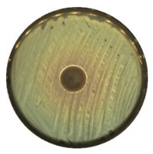 | 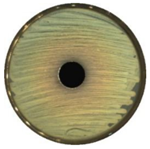 | 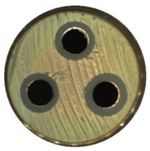 |
| (b) | 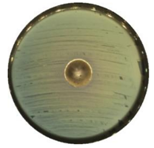 | 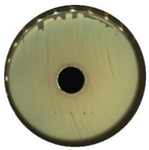 | 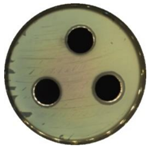 |
Publisher’s Note: MDPI stays neutral with regard to jurisdictional claims in published maps and institutional affiliations. |
© 2020 by the authors. Licensee MDPI, Basel, Switzerland. This article is an open access article distributed under the terms and conditions of the Creative Commons Attribution (CC BY) license (http://creativecommons.org/licenses/by/4.0/).
Share and Cite
Kubiak, A.; Kubacka, M.; Gabała, E.; Dobrowolska, A.; Synoradzki, K.; Siwińska-Ciesielczyk, K.; Czaczyk, K.; Jesionowski, T. Hydrothermally Assisted Fabrication of TiO2-Fe3O4 Composite Materials and Their Antibacterial Activity. Materials 2020, 13, 4715. https://doi.org/10.3390/ma13214715
Kubiak A, Kubacka M, Gabała E, Dobrowolska A, Synoradzki K, Siwińska-Ciesielczyk K, Czaczyk K, Jesionowski T. Hydrothermally Assisted Fabrication of TiO2-Fe3O4 Composite Materials and Their Antibacterial Activity. Materials. 2020; 13(21):4715. https://doi.org/10.3390/ma13214715
Chicago/Turabian StyleKubiak, Adam, Marta Kubacka, Elżbieta Gabała, Anna Dobrowolska, Karol Synoradzki, Katarzyna Siwińska-Ciesielczyk, Katarzyna Czaczyk, and Teofil Jesionowski. 2020. "Hydrothermally Assisted Fabrication of TiO2-Fe3O4 Composite Materials and Their Antibacterial Activity" Materials 13, no. 21: 4715. https://doi.org/10.3390/ma13214715
APA StyleKubiak, A., Kubacka, M., Gabała, E., Dobrowolska, A., Synoradzki, K., Siwińska-Ciesielczyk, K., Czaczyk, K., & Jesionowski, T. (2020). Hydrothermally Assisted Fabrication of TiO2-Fe3O4 Composite Materials and Their Antibacterial Activity. Materials, 13(21), 4715. https://doi.org/10.3390/ma13214715







